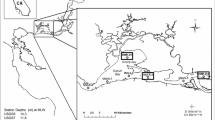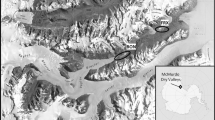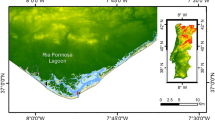Abstract
Phytoplankton productivity and the factors that influence it were studied in the Logan River and southern Moreton Bay, a large embayment on the east coast of Australia. Phytoplankton productivity, dissolved and total nutrient concentrations, and turbidity were determined throughout high and low rainfall periods to characterize light and nutrient influences on productivity. Turbidity and nutrient concentrations were highest at upriver sites, but productivity was highest at the river mouth and within the river plume. Phytoplankton productivity peaked after rainfall events (>150 mg C m−3 h−1), commensurate with a decrease in dissolved nitrogen concentrations. Productivity responses to increased nutrient concentrations and light availability were determined in laboratory incubations. During summer, productivities at the bay sites were stimulated by nitrogen (N) enrichment, while productivities at upriver sites were stimulated by phosphorus (P) addition. Light stimulation of productivities was more pronounced at upriver sites than bay sites. The relative magnitude of nutrient and light stimulation of productivities indicate a predominance of light limitation upriver, significant N limitation within the Logan River plume, and little effect of light, N, or P at sites beyond the Logan River plume. Productivity decreased with seasonal decreases in temperature. Lower water temperatures in winter probably helped determine maximum rates of phytoplankton productivity. The combination of light and N limitation of productivity during summer, and temperature limitation during winter, account for low areal productivities (<0.6 g C m−2 d−1), compared with other rivers and estuaries worldwide.
Similar content being viewed by others
Literature Cited
Abal, E. G. and W. C. Dennison. 1996. Seagrass depth range and water quality in southern Moreton Bay, Queensland, Australia.Marine and Freshwater Research in press.
Chiffings, A. W. 1979. Cockburn sound study. Technical report on nutrient enrichment and phytoplankton. Western Australia Department of Conservation and Environment: Report No. 3. Perth, Australia.
Clesceri, L. S., A. E. Greenberg, andR. R. Trussel. 1989. Standard Methods for the Examination of Water and Wastewater, 17th edition. American Public Health Association, Washington.
Cole, B. E. andJ. E. Cloern. 1987. An empirical model for estimating phytoplankton productivity in estuaries.Marine Ecological Progress Series 36:299–305.
D'Elia, C. F., J. G. Sanders, andW. R. Boynton. 1986. Nutrient enrichment studies in a coastal plain estuary: Phytoplankton growth in large-scale, continuous cultures.Canadian Journal of Fisheries and Aquatic Science 43:387–406.
Dring, M. J. 1992. The Biology of Marine Plants. Cambridge University Press, Cambridge. United Kingdom.
Eppley, R. W. 1972. Temperature and phytoplankton growth in the sea.Fishery Bulletin 70:1063–1085.
Eyre, B. and C. Twigg. 1996. Nutrient behaviour during postflood recovery of the Richmond River estuary northern NSW, Australia.Estuarine, Coastal and Shelf Science in press.
Finlayson, B. L. andT. A. McMahon. 1988. Australia v the world: A comparative analysis of streamflow characteristics, p. 17–40.In R. F. Warner (ed.), Fluvial Geomorphology of Australia. Academic Press, Australia.
Fisher, T. R., L. W. Harding, D. W. Stanley, andL. G. Ward. 1988. Phytoplankton, nutrients, and turbidity in the Chesapeake, Delaware, and Hudson estuaries.Estuarine, Coastal and Shelf Science 27:61–93.
Fisher, T. R., E. R. Peele, J. W. Ammerman, andL. W. Harding, Jr. 1992. Nutrient limitation of phytoplankton in Chesapeake Bay.Marine Ecological Progress Series 82:51–63.
Fox, L. E. 1989. A model for inorganic control of phosphate concentrations in river waters.Geochimica et Cosmochimica Acta 53:417–428.
Furnas, M. andA. W. Mitchell. 1987. Phytoplankton dynamics in the central Great Barrier Reef-II. Primary production.Continental Shelf Research 7:1049–1062.
Geider, R. J. 1987. Light and temperature dependence of the carbon to chlorophylla ratio in microalgae and cyanobacteria: Implications for physiology and growth of phytoplankton.New Phytologist 106:1–34.
Glibert, P. M., D. J. Conley, T. R. Fisher, L. W. Harding, Jr., andT. C. Malone. 1995. Dynamics of the 1990 winter/spring bloom in Chesapeake Bay.Marine Ecological Progress Series 122:27–43.
Goldman, J. C., J. J. McCarthy, andD. G. Peavey. 1979. Growth rate influence on the chemical composition of phytoplankton in oceanic waters.Nature 179:210–215.
Goldman, J. C. andP. M. Glibert. 1983. Inorganic uptake by phytoplankton, p. 233–274.In E. Carpenter and D. Capone (eds.) Nitrogen and the Marine Environment. Academic Press, New York.
Harding, Jr.,L. W., B. W. Meeson, andT. R. Fisher. 1986. Phytoplankton production in two East Coast estuaries: Photosynthesis-light functions and patterns of carbon assimilation in Chesapeake and Delaware bays.Estuarine and Coastal Shelf Science 23:773–806.
Harrison, P. J., P. J. Clifford, W. P. Cochlan, K. Yin, M. A. St John, P. A. Thompson, M. J. Sibbald, andL. J. Albright. 1991. Nutrient and plankton dynamics in the Fraser River plume, Strait of Georgia, British Columbia.Marine Ecological Progress Series 70:291–304.
Hecky, R. E. andP. Kilham. 1988. Nutrient limitation of phytoplankton in freshwater and marine environments: A review of recent evidence on the effects of enrichment.Limnology and Oceanography 33:796–822.
Horrocks, J., G. R. Stewart, andW. C. Dennison. 1995. Tissue nutrient content ofGracilaria spp. (Rhodophyta) and water quality along an estuarine gradient.Marine and Freshwater Research 46:975–983.
Howarth, R. W. 1988. Nutrient limitation of net primary production in marine ecosystems.Annual Review of Ecology 19:89–110.
Hyland, S. J., A. J. Courtney, andB. T. Butler. 1989. Distribution of seagrass in the Moreton region from Coolangatta to Noosa. Queensland Department of Primary Industry, Information Services Bookler. Brisbane, Australia.
Jones, A., W. C. Dennison, andG. R. Stewart. 1996. Macroalgal responses to nitrogen source and availability: Amino acid metabolic profiling as a bioindicator usingGracilaria edulis (Rhodophyta).Joural of Phycology 32:757–766.
Magnien, R. E., R. M. Summers, andK. G. Sellner. 1992. External nutrient sources, internal nutrient pools, and phytoplankton production in Chesapeake Bay.Estuaries 15:487–516.
Mallin, M. A. 1994. Phytoplankton ecology of North Carolina estuaries.Estuaries 17:561–574.
Mallin, M. A., H. W. Paerl, andJ. Rudek. 1991. Seasonal phytoplankton composition, productivity and biomass in the Neuse River estuary, North Carolina.Estuarine and Coastal Shelf Science 32:609–623.
Malone, T. C., T. H. Crocker, S. E. Pike, andB. W. Wendler. 1988. Influences of river flow on the dynamics of phytoplankton production in a partially stratified estuary.Marine Ecological Progress Series 48:235–249.
Moss, A. J. 1990. Turbidity and nutrient behaviour in the estuary, p. 307–331.In P. Davie, E. Stock, and E. Choy (eds.), The Brisbane River. Australian Littoral Soceity, Brisbane, Australia.
Moss, A. J., D. Connell, andB. Bycroft. 1992. Water quality in Moreton Bay, p. 103–114.In O. Crimp (ed.) Moreton Bay in the Balance. Australian Littoral Society/Australian Marine Science Consortium. Brisbane, Australia.
Motoda, S., T. Kawamura, andA. Taniguchi. 1978. Differences in productivities between the Great Australian Bight and the Gulf of Carpentaria, Australia, in summer.Marine Biology 46:93–99.
Pailles, C. andP. W. Moody. 1992. Phosphorus sorption-desorption by some sediments of the Johnstone Rivers catchment, northern Queensland.Australian Journal of Marine and Freshwater Research 43:1535–1545.
Parsons, T. R., Y. Maita, andC. M. Lalli. 1984. A Manual of Chemical and Biological Methods for Seawater Analysis. Pergamon Press. Oxford.
Patterson, D. C. andC. L. Witt 1992. Hydraulic processes in Moreton Bay, p. 25–40.In O. Crimp (ed.) Moreton Bay in the Balance. Australian Littoral Society/Australian Marine Science Consortium, Brisbane, Australia.
Queensland Department of Environment and Heritage. 1993. Water quality data report Queensland, January 1988 to December 1991. Queensland Department of Environment and Heritage, Environment Data Report No. 4. Brisbane, Australia.
Quinn, R. H. 1992. Fisheries resources of the Moreton Bayregion. Queensland Fish Management Authority, Brisbane, Australia.
Redfield, A. M. 1958. The biological control of chemical factors in the environment.American Scienctist 46:205–202.
Richardson, K. andA. Christoffersen. 1991. Seasonal distribution and production of phytoplankton in the southern Kattegat.Marine Ecological Progress Series 78:217–227.
Rothlisberg, P. C., P. C. Pollard, P. D. Nichols, D. J. W. Moriarty, A. M. G. Forbes, C. J. Jackson, andD. Vaudrey. 1994. Phytoplankton community structure and productivity in relation to the hydrological regime of the Gulf of Carpentaria, Australia, in summer.Australian Journal of Marine and Freshwater Research 45:265–282.
Rudek, J., H. W. Paerl, M. A. Pallin, andP. W. Bates. 1991. Seasonal and hydrological control of phytoplankton nutrient limitation in the lower Neuse River estuary, North Carolina.Marine Ecological Progress Series 75:133–142.
Ryther, J. H. 1971. Photosynthesis in the ocean as a function of light intensity.Limnology and Oceanography 1:61–70.
Ryther, J. H. andW. M. Dunstan. 1971. Nitrogen, phosphorus and eutrophication in the coastal marine environment.Science 171:1008–1013.
Schindler, D. W. 1977. The evolution of phosphorus limitation in lakes.Science 195:260–262.
Smith, S. V. 1984. Phosphorus versus nitrogen limitation in the marine environment.Limnology and Oceanography 29:1149–1160.
Udy, J. W. and W. C. Dennison. 1997. Growth and physiological responses of three seagrass species to elevated sediment nutrients in Moreton Bay, Australia.Journal of Experimental Marine Biology and Ecology. In Press.
Young, P. C. andH. Kirkman. 1975. The seagrass communities of Moreton Bay, Queensland.Aquatic Botany 1:191–202.
Author information
Authors and Affiliations
Corresponding author
Rights and permissions
About this article
Cite this article
O’Donohue, M.J.H., Dennison, W.C. Phytoplankton productivity response to nutrient concentrations, light availability and temperature along an Australian estuarine gradient. Estuaries 20, 521–533 (1997). https://doi.org/10.2307/1352611
Received:
Accepted:
Issue Date:
DOI: https://doi.org/10.2307/1352611




